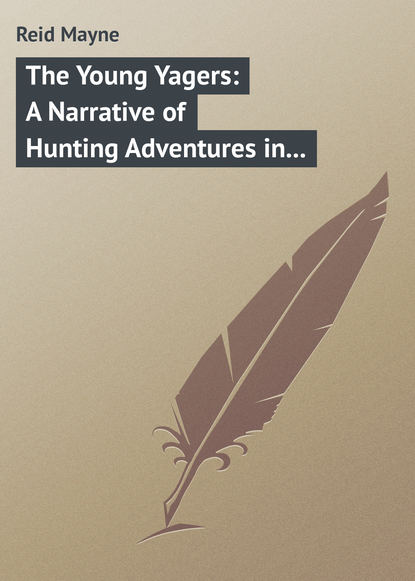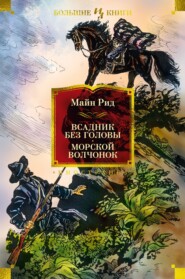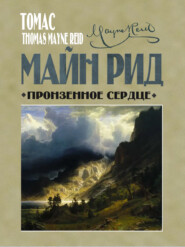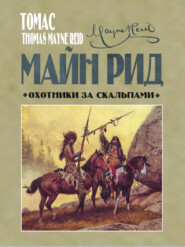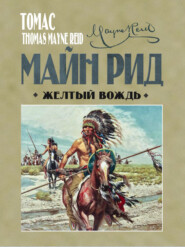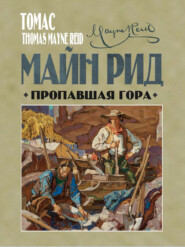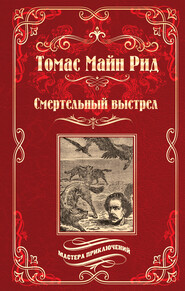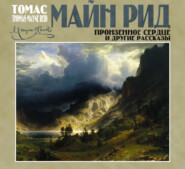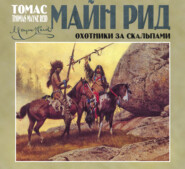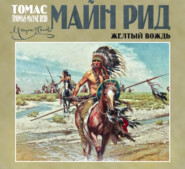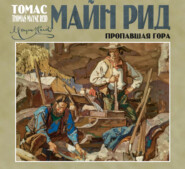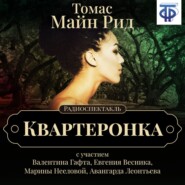По всем вопросам обращайтесь на: info@litportal.ru
(©) 2003-2024.
✖
The Young Yagers: A Narrative of Hunting Adventures in Southern Africa
Настройки чтения
Размер шрифта
Высота строк
Поля
Its colour was of a very dark glossy brown, or nearly black, upon the head and over the upper parts of the body. Around the neck was a collar of orange rufous, which grew paler upon the breast, ending in a buff tinge over the abdomen, lower parts of the body, and thighs.
But it was in the tail-feathers that the peculiarity of this bird appeared. Of these, two were immensely long, set vertically, or “edgeways,” and curving far outward and downward. Two others, much shorter, also stood out edgeways above the first. These were broadly webbed at their bases, being at their widest rail three inches across; while their tips, for the length of three inches more, were entirely without any feathery web, and looked like a pair of stiff hairy spines projecting outward. Besides these two pairs of vertical feathers, there were four others on each side of the tail, nicely graduated one above the other, each being about a quarter of an inch shorter than the one immediately below it. All these tail-feathers were black.
But one of these birds was seen by the boys at their camp; but they noticed that it was accompanied by another bird of a rusty brown and whitish colour, and with a tail of the ordinary kind. This companion was neither more nor less than the female; while the gaudy creature with the orange colour and long tail-plumes was the male.
Hans’s knowledge was now brought into requisition, for the others had never seen this curious bird, and knew not to what species it belonged. Hans told them it also was one of the weaver-birds; known among naturalists by the name Vidua; among the French as “La veuve;” and among the English as “Widow-bird.” All of the party regarded this as a very singular name for the bird; and at once called upon the naturalist for an explanation of it. Fortunately, Hans was able to give them this; and that was more than the learned Brisson – he who baptised it Vidua and La veuve– has been able to do.
“Brisson,” said Hans, “has named the little creature ‘widow-bird,’ because he had heard that it was so called among the Portuguese; and the French naturalist assigns as a reason that it was so called on account of its colour and long tail! Such writers as Monsieur Brisson and Monsieur Buffon are never at a loss for reasons. Now it so happens that neither its colour nor tail had any thing to do with the origin of its name ‘widow-bird,’ which of itself is quite a misnomer. The Portuguese, who first drew attention to this bird, called it ‘Whidah’ bird, from the fact that it was received by them from the kingdom of Whidah in Western Africa. That is the way in which the bird has received its appellation.”
The Whidah-bird, on account of its livery habits, but more from the singularity of its tail-plumes, is a great favourite as a pet: and is often seen in cages, where it hops from perch to perch without fear of constraint, and alternately depresses and elevates its long tail with great vivacity. It is usually fed upon grain and several kinds of herbs, and is exceedingly fond of bathing itself in water. It moults twice a year; and during one period the male loses the long plumes which distinguish him from his mate, and altogether becomes so changed in colour, that the sexes are not then very easily told apart. It is only during the breeding season that the cock Whidah-bird attains his fine tail, and the orange and black colours of his plumage.
There are two species of Whidah-birds known to naturalists. The “Paradise widow-bird” (Vidua paradisea) is the one described above; and another which is called the “Red-billed widow-bird,” (Vidua erythrorhynca). The latter is a smaller species, and differs from the other in the arrangement of the tail-feathers. Its bill is of a deep red colour – whence the trivial name; and its plumage is of a bluish-black upon the upper parts of the body, with a white collar around the neck, white wing coverts, and whitish underneath.
Its habits, however, are precisely similar to those of the species Paradisea; and both are found inhabiting the same countries, viz: Western Africa. The range of neither reaches as far southward as the Cape Colony, but one of the species extends to the countries northward of the great Orange River, and is occasionally, though rarely, seen.
On account of its rarity in these parts, the young yägers, and particularly the naturalist Hans, were desirous of obtaining its skin; and for this purpose the shot-guns were levelled, and both the “widows” were ruthlessly brought down from their perch.
Chapter Forty Five.
The Pique-Boeufs
Of course Hans, aided by the others, immediately set about skinning the widow-birds, with an eye to their being preserved. Arend was his principal assistant, for Arend was clever with his hands; and was, moreover, as good a taxidermist as Hans himself. It never troubled Arend to know the genus or species of a bird; but give him the bird itself, and he could strip off its skin and mount it without leaving a trace of a ruffled feather.
While thus engaged, a noise fell upon the ears of the young yägers that caused all of them to start – Hans and Arend dropping the skins of the widow-birds, upon which they had been operating.
The noise which produced this startling effect, was neither more nor less than the cry of a bird, and but a small bird at that. The note very much resembled the well-known call of the mistle-thrush or screech-cock, (Turdus viscivorus). It was no louder, and the bird that uttered it was no bigger than this thrush; but for all that, the note produced a somewhat terrifying effect upon the yäger camp. All of the party, both yägers and attendants, knew the cry well. Even the buck-dogs sprang to their feet, and howled as it reached their ears; and the whole camp was suddenly in a commotion.
Now, my young reader, you will wonder why the cry of a bird, not bigger than a blackbird, could create terror in the minds of such courageous boys as our yägers; and you will naturally desire to know what sort of bird this was.
I have said the boys all knew it, the attendants and the dogs. Nay, more, the horses and oxen recognised that cry; and its effect on them was not less wonderful; for the moment it was heard, the horses tossed up their heads, snorted as if in terror, and commenced stampeding over the ground. The oxen exhibited similar symptoms of affright. Yes, horses, oxen, dogs, Kaffir, Bushman, and yägers, were all affected by the screech of that bird, as it pealed along the rocks, and echoed through the glen. All recognised in it the warning cry of the Pique-Boeuf!
An account of this singular bird will explain the cause of the consternation which its note had thus suddenly produced.
The “Pique-Boeuf” is about the size of a starling, of a greyish colour over the body, with short wings, and tail somewhat of a darker hue. Its feet are formed for grasping, and its claws are hooked and compressed. The most remarkable part of the bird is its bill. This is of a quadrangular shape, the lower mandible much stronger than the upper one, and both swelling towards the tip, so as to resemble a forceps or pincers. The purpose of this formation will be seen, when we come to speak of the habits of the bird.
These are, indeed, peculiar; and, by the laws of ornithology, stamp the Pique-Boeufs as a distinct genus of birds.
A celebrated French ornithologist, and a true field naturalist as well – Le Vaillant – thus describes the habits of these birds: —
“The bill of the Pique-Boeuf is fashioned as a pair of solid pincers, to facilitate the raising out of the hides of quadrupeds the larvae of the gadflies, which are there deposited and nourished. The species, therefore, anxiously seek out the herds of oxen, of buffaloes, of antelopes – of all the quadrupeds, in short, upon which these gadflies deposit their eggs. It is while steadied, by a strong gripe of the claws in the tough and hairy hide of these animals, that, with strong blows of the bill and powerful squeezes of the skin, at the place where the bird perceives an elevation, which indicates the presence of a maggot, he extracts it with effect. The animals, accustomed to the treatment, bear with the birds complacently, and apparently perceive the service which they render them, in freeing them from these true parasites, which live at the expense of their proper substance.”
Now, there are many species of birds, as well as the Pique-Boeufs, that lead a very similar life, living principally upon the parasite insects that infest the bodies of the larger quadrupeds, both wild and tame. In America, the “cow-bunting” (Icterus pecoris) is so termed from its habit of feeding upon the parasite insects of cattle; and among other animals it is a constant attendant upon the immense herds of buffaloes that roam over the great American prairies. Other species of icterus also frequent the vast cattle-herds of the South American plains.
The red-billed weaver-bird (Textor erythrorhynchus) is equally the companion of the African buffalo; and any one who has visited an extensive sheep-pasture cannot fail to have observed the common starling perched upon the woolly backs of the sheep. The white-necked crow (Corvus albicollis) is noted for similar practices, as well as several other species of Corvidae and Sturnidae. All of these kinds, however – the white-necked crow excepted – content themselves with only taking away the parasites, which are attached to the skins of the animals, or such as live among the hair and wool – none of the aforesaid birds having in their bills the necessary strength for extracting the maggots which are lodged beneath. Now, with the Pique-Boeufs, there is no difficulty about this. Their peculiar beaks enable them to penetrate the toughest hides of the large quadrupeds; and although they also feed upon the ticks and other parasites that rest upon the surface, they prefer the larvae that lie beneath. Hence, these birds are entitled to be regarded as distinct from any of the others; and naturalists have formed them into a separate genus – the genus Buphaga, or “beef-eaters.”
It is scarcely necessary to point out the absurdity of this name, which seems to have been given from a misapprehension of the habits of the birds. The Pique-Boeuf is no beef-eater, but a “beef-picker,” if you will, as the French phrase very properly expresses it. But M. Brisson, who gave the name, seems very much to have resembled his more celebrated countryman – the great closet naturalist, Buffon – in ascribing such habit to birds and animals as suited his fancy.
Buphaga is the name given, and so let it stand.
Only two species have been yet observed. One is the Buphaga erythrorhyncha, or red-billed beef-eater – so called from the colour of its beak, which is a beautiful coral-red – while the more common species already described has a yellow beak. The latter is the Buphaga Africana. Both species are birds of Africa – the “coral bill” (Bec corail) being also a native of the island of Madagascar. The “coral bill” is smaller than the Buphaga Africana, and somewhat different from it in colour. The tint of its plumage is more sombre. The upper parts, head and throat, are of an ash-brown, glazed, as it were, with bluish; and beneath, the bird is of a yellowish rust colour. Its bill, also, is smaller and less powerful than that of its congener.
The Pique-Boeufs are generally seen in company; but they never fly in large flocks. Six or eight of them may usually be observed together. They are very wild shy birds, and it is difficult to approach within shooting distance of them.
The only chance of getting near enough is to approach behind the body of an ox, or some other animal – using the latter as a stalking-horse, and driving it gently towards those beasts on whose back the birds may be perched. The gunner, by then showing himself suddenly, may obtain a shot at them on the wing.
Such are the habits of the Pique-Boeufs. But all this does not explain why it was that the screech of one of these birds had thrown the camp of the young yägers into such a state of excitement or alarm. The reason remains to be told. It was this: —
Of all the quadrupeds to which the Pique-Boeufs attach themselves, there are none upon which they are such constant attendants as the rhinoceros. This animal is the victim of many parasitical insects – of ticks and larvae. His huge body and corrugated skin, of such vast extent, offer an ample field for such creatures, and consequently afford a supply of food to the Pique-Boeuf, which is unfailing.
The rhinoceroses, therefore, of all the four species that inhabit South Africa, are always attended by the beef-eaters, which, on this account, are known among hunters as “rhinoceros-birds.” Go where the rhinoceros will, the Pique-Boeufs follow him, perching upon his back, his head, or any other part of his body, and remaining there quite unconcernedly, as if they regarded that situation as their natural roosting-place and home. The rhinoceros himself never dreams of molesting them. On the contrary, he finds their presence extremely useful to him. Not only do they give him ease, by destroying the insects that would otherwise annoy him, but in another sense they do him an essential service. They warn him of the approach of the hunter, or any other danger. The moment such appears, the rhinoceros, who himself may have been asleep, is instantly aroused by the harsh screeching of the birds, and put upon his guard. Should their voices fail to awake him, these cunning sentinels will flutter around his head, and peck into his ears until they succeed in giving the alarm. With elephants and hippopotami they act in a similar manner; so that one of the difficulties to be encountered by the hunter in pursuit of these animals, is the vigilance of the little winged sentinel that thus keeps watch over their sleep!
It was this curious habit, then – well known to every creature in the camp – that caused all hands to start up on hearing the screech of the Pique-Boeuf. The presence of the bird announced the proximity of the dangerous “rhinoster.”
Chapter Forty Six.
Charged by “Muchochos.”
All eyes were instantly turned in the direction whence came the “skreek” of the bird, and there, sure enough, were a brace of rhinoceroses of the biggest kind. They were just entering the little glen, through the gap before mentioned; and were coming down the channel of the river, plunging through the water as they walked knee-deep.
The superior size of their bodies, as well as their colour, told they were white rhinoceroses; and the long horn upon the snout, pointing slightly backward instead of forward, showed they were of that species known among the natives as “muchocho,” and among naturalists as Rhinoceros simus.
The other species of white rhinoceros is the “kobaoba,” lately named Rhinoceros Oswellii; although in my opinion it should have been Rhinoceros Cummingii– since the great lion-hunter was not only the first to give any definite characteristics of this rare species, but more than any other man has he contributed to a knowledge of the South African fauna.
The principal distinction between the kobaoba and muchocho is observed in the set and size of the horns. In neither species is the posterior horn any thing more than a conical knob of six or seven inches in length; but in each the anterior horn is very long – far exceeding that of the black rhinoceroses. In the kobaoba, this horn sometimes reaches to the enormous length of four feet, and even exceeds that measurement; while in the muchocho, three feet is the limit. In the former the horn projects forward, standing at an angle of forty-five degrees with the line of the snout; whereas that of the muchocho is erect, with a slight curve or sweep backwards.
Both species far exceed in size the two kinds of black rhinoceros, and are fully equal to their great Asiatic congener – he with the curious shield-like skin, so well known in picture-books, museums, and zoological gardens. In other words, the white rhinoceroses of South Africa are in point of magnitude, after the elephant, the largest quadrupeds in the world. In point of habits they differ altogether from the black species. They are grass-feeders, as the shape of their muzzle testifies; while the black kinds browse upon various kinds of shrubs and acacia thorns, and are furnished with a prehensile lip for the purpose of more easily grasping the twigs and branches.
As has been elsewhere observed, in disposition the two kinds are also very different. The black rhinoceroses – both “borelé” and “keitloa” – are of an extremely vicious and malignant nature, and more dangerous even than the lion. They are swift of foot; and, but for their defective powers of vision, it would be a perilous thing to approach them. The white species, on the contrary, are slow, and less disposed to make an attack upon man. When these are wounded, or are accompanied by their young, the case is different. They then exhibit all the ferocity of their race; and many a native hunter has fallen a victim to the rage of both the kobaoba and muchocho.
The flesh of the two last-named species is excellent eating – being almost as good as fresh pork. It is not so with the flesh of the black rhinoceros, which is strong, rancid, and bitter.
Now, knowing the general disposition of the “muchochos,” and knowing also the delicate flesh which these animals afford to the hunter, our young yägers at seeing them lost all sense of alarm. They at once rushed to their guns, and commenced preparing to receive the advancing quadrupeds. Had it been borelés or keitloas, they would have acted differently; and would, perhaps, have thought only of flying to their horses, or of ensconcing themselves in the wagons. Of white rhinoceroses, however, they had no fear; and having armed themselves, they advanced boldly and openly to the conflict.
By this time the muchochos had got fairly through the pass; and, climbing out of the river-channel, stood up on the grassy sward of the meadow. Their naked bodies, thus fully exposed to view, appeared of enormous size. One, however, was much bigger than the other – in fact, quite as large as a female elephant – for it was full sixteen feet in length from the tip of its long blunt snout to the “whisk” upon the top of its short tail.
But what caused astonishment to the advancing hunters was the fact, that instead of the two of these animals which they had already seen, three now appeared upon the bank. The third, however, was not larger than an ordinary hog; and, excepting that its snout wanted the characteristic horn, it might have passed for a miniature of the other two. Small as it was, there was no mistaking it for any other animal than a rhinoceros; and its size as well as actions showed that it was the young, or “calf,” of the two old ones, that were respectively its male and female parent.
The hunters were delighted with this new discovery. The flesh of the young white rhinoceros is much more delicate and tender than that of the full-grown ones; and all of them, but particularly Swartboy and Congo, now indulged in the anticipation of a rare treat.
No one thought of the increased danger of their thus attacking the rhinoceros in company with its young. That was forgotten in the hurry and excitement of the moment. The prudent Hans alone had some misgivings; but carried away by the enthusiasm of his companions, he failed to make them known. In ten seconds afterwards a volley of reports rang through the little glen; and by that same volley a shower of bullets – varying in size from the large ounce-ball of the elephant-gun to the small pea of the rifle – was poured upon the muchochos.
The only visible effect produced upon the animals was to cause them suddenly to change their gait, from the slow waddle at which they had been advancing, to a brisk rapid gallop, which was directed precisely toward the spot where the hunters were standing! At the same time the huge animals were heard to snort and blow like porpoises; and the sparkling of their small eyes, the quick lashing of their saucy tails, and the long horns set horizontally, showed that they were charging forward in the full bent of their fury. The “calf” followed in the rear, imitating the noise and actions of its ponderous parents.
This to the hunters was a movement wholly unexpected. Had it been borelé or keitloa there would have been nothing strange in it. On the contrary, it was just as either of the black rhinoceroses would have acted. But from muchocho – usually so harmless as to be called cowardly and stupid – an attack of this nature was quite unlooked for. The report of a gun, or even the barking of a dog, will usually put the muchocho to flight.
But our yägers had not reasoned correctly when they expected these either to fall to their shots, or take to instant flight. They had forgotten the presence of the calf. That it was which caused the white rhinoceroses to act upon this occasion contrary to their usual habit – that, and perhaps the wounds they had received – for several of the bullets, although not fatal, had made painful wounds. So much the worse.
Of course, none of the young yägers stood their ground to receive this heavy charge. Their guns were now empty, and it would have been of no use. On the contrary, each and every one of them turned instanter; and no mischievous urchin ever ran faster from a parish beadle than did all six of them towards the camp. The tails of their coats made a considerable angle with the line of their backs, as they “sloped” across the level sward of that little meadow.





